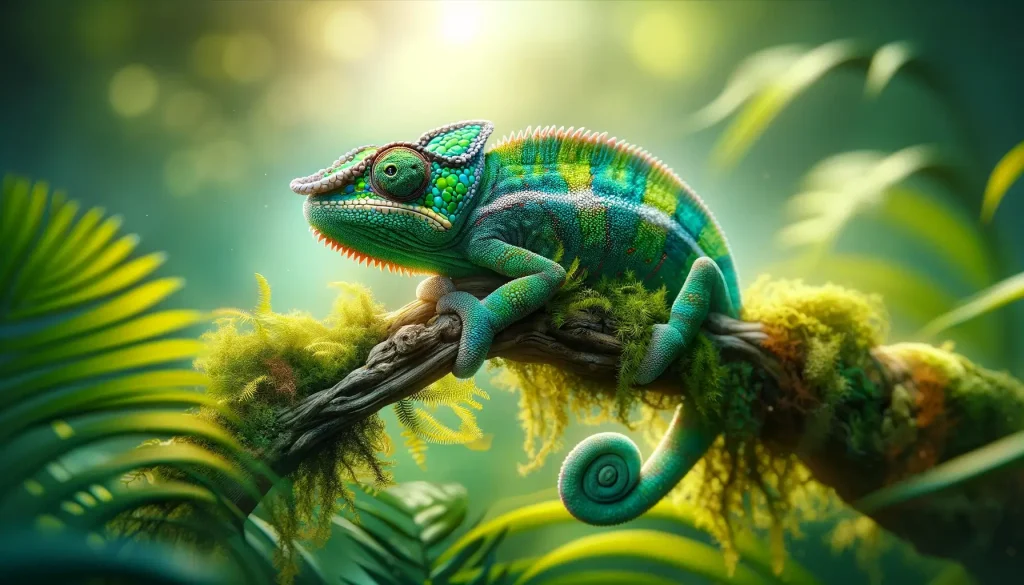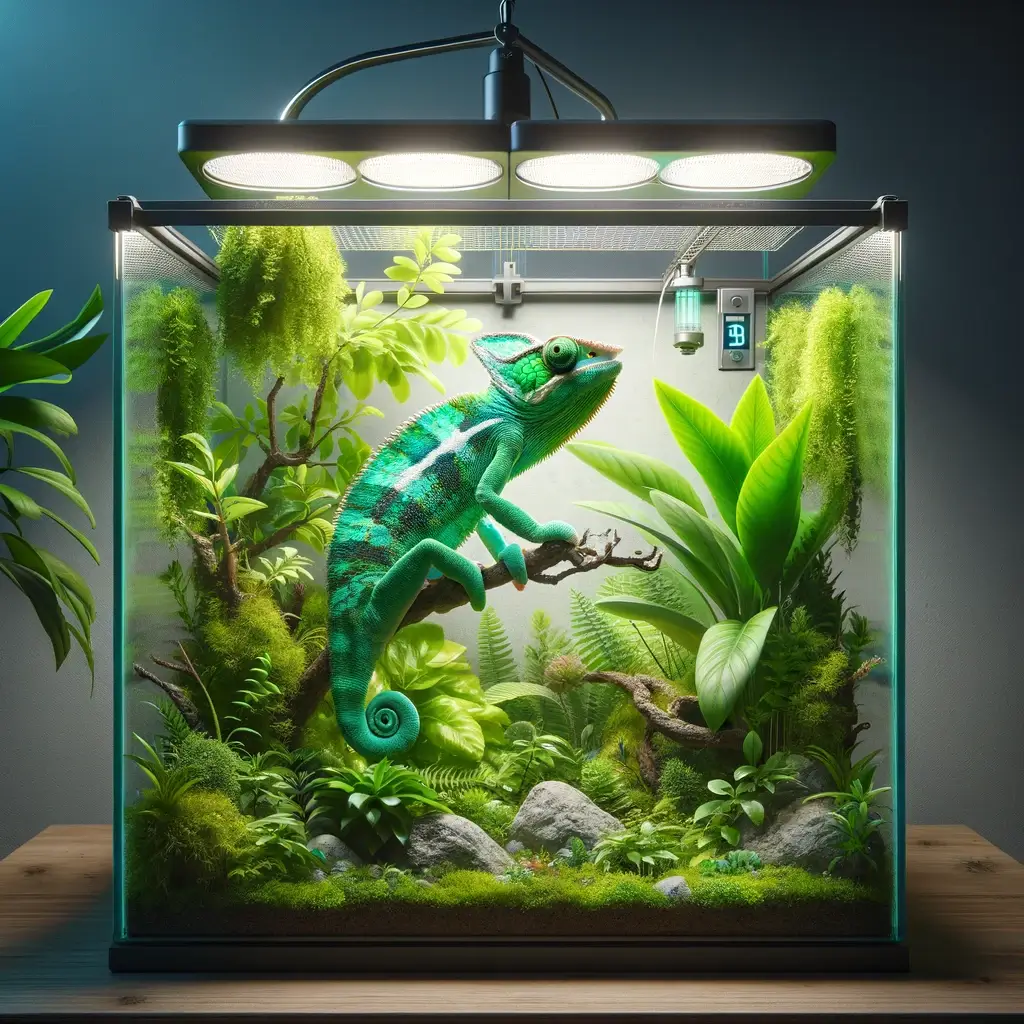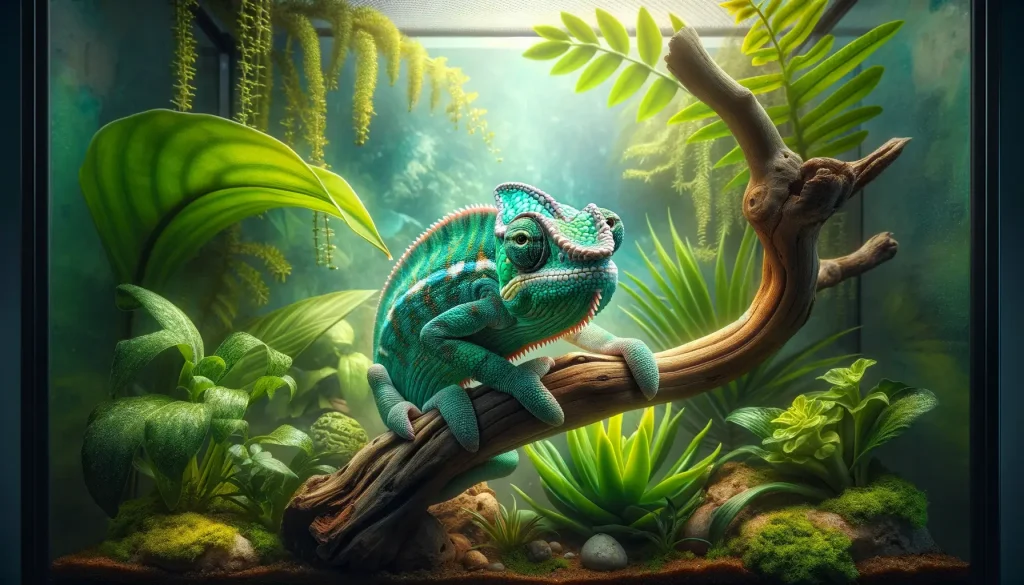
Chameleon Care
Chameleons are fascinating creatures, known for their vivid colors and unique characteristics. From the vast forests of Madagascar to your home, these reptiles require specific care to thrive. In this article, we decode the essentials of chameleon care, aiming to foster a deeper understanding and connection between you and your pet. Let’s dive into the world of chameleons, where every detail counts towards creating a healthy and joyful environment for these remarkable reptiles.
Understanding chameleon care is not just about meeting their basic needs; it’s about empowering you as an owner. With the right knowledge, you can ensure your chameleon not only survives but thrives. Our guide will cover everything from choosing the right species to creating the perfect habitat, diet, health monitoring, and beyond. Let’s embark on this journey together, ensuring your chameleon’s life is as vibrant as its colors.
Chameleon Care: FAQs
Got questions about chameleon care? You’ve come to the right place. We’ve compiled the most common queries to help you become a more informed and confident chameleon owner.
What species of chameleon is best for beginners?
Veiled chameleons (Chamaeleo calyptratus) are often recommended for first-time chameleon owners due to their hardiness. Another good choice is the Oustalet’s chameleon (Furcifer oustaleti), known for being quite durable and able to adapt to a range of conditions.
How big should my chameleon’s enclosure be?
A chameleon’s cage size depends on its species, but a general rule for an adult chameleon is at least 2 feet wide by 2 feet deep by 4 feet tall. Younger or smaller species can start in smaller enclosures, but they grow quickly.
What temperatures are ideal for a chameleon?
Chameleons need a temperature gradient in their enclosure. The basking area should be between 85°F to 95°F, while the cooler end of the habitat should be between 70°F to 80°F. At night, temperatures can drop to 65°F to 70°F.
Do chameleons need humidity?
Yes, chameleons require a humidity level of 50%-70%. Regular misting, a drip system, or a humidifier can help maintain the correct humidity levels.
What do chameleons eat?
Chameleons primarily eat insects. Staples can include crickets, worms, and roaches. It’s important to dust food with calcium and vitamin supplements regularly to prevent nutritional deficiencies.
Can chameleons be handled?
While some chameleons tolerate handling better than others, they are generally not fond of it. Excessive handling can stress them out. It’s best to limit handling to cleaning or health checks.
How do I know if my chameleon is sick?
Signs of illness in chameleons can be subtle. Watch for lethargy, lack of appetite, discoloration, drooping eyes, or difficulty moving. Regular vet checks are recommended to catch and address issues early.I’m sorry for any confusion, but it seems there was an issue with the provided input, leading to an unclear request. Could you please clarify or provide more specific instructions for the content you need?

Insights into Chameleon’s Colorful World
In this section, we’ll dive into some intriguing chameleon facts that showcase why these reptiles are such captivating pets. If you’re keen on understanding your scaly friend better or simply fascinated by these creatures, you’re in for a treat. Let’s explore.
- Color Changing Magic: Chameleons are famous for their ability to change colors, but it’s not just for camouflage as commonly thought. This phenomenon is primarily used to regulate their temperature or communicate with other chameleons.
- Independently Mobile Eyes: One of the most fascinating aspects of a chameleon’s anatomy is its eyes. They can move independently, allowing them to look in two different directions at once. This gives them a full 360-degree field of vision.
- Lightning-Fast Tongue: A chameleon’s tongue can shoot out to capture prey in just 0.07 seconds. To put that in perspective, it’s over five times faster than the blink of an eye.
- Longevity: With proper care, some chameleon species can live up to 10 years in captivity. The key to their longevity includes a well-maintained habitat, a nutritious diet, and regular health checks.
- Masters of Disguise: Beyond changing colors, chameleons can also adjust their body shape and appearance to mimic specific environmental elements, like leaves or branches, to evade predators.
Chameleons are a testament to nature’s magic, combining fascinating physical features with behaviors that leave us in awe. Whether it’s their color-changing ability, unique vision, or their surprisingly rapid tongue movements, there’s always something new to learn about these incredible creatures.
Ideal Home for Your Chameleon
Setting up the right habitat is crucial for your chameleon’s health and happiness. Here’s how to do it.
Choose the right enclosure. Screened cages are best for chameleons due to their need for proper ventilation. Glass aquariums, though common, are not ideal as they can restrict airflow and lead to respiratory issues.
Lighting is key. Chameleons require both UVA and UVB lighting to properly metabolize calcium and maintain a healthy skeletal system. Install a UVB light source and ensure it covers at least two-thirds of the top of the enclosure.
Plant life matters. Incorporating live plants not only makes the habitat more aesthetically pleasing but also provides hiding spots and maintains humidity. Ficus, hibiscus, and pothos are great options.
Proper substrate. While many opt for bare-bottom cages for easy cleaning, adding a substrate like coconut fiber can help maintain humidity levels. Avoid substrates that can cause impaction if ingested.
Water needs. Chameleons don’t drink from a water bowl. They prefer licking water droplets off leaves. Incorporating a drip system or misting the enclosure twice daily is necessary for their hydration.


Chameleon Fur Facts
In this special section, we delve into some specifics that make chameleons unique in the pet world.
- Chameleons have zygodactyl feet, with two toes pointing forward and two backward, which helps them grip branches securely.
- Despite popular belief, color changes in chameleons are not just for camouflage. These changes communicate their mood, defend territory, and attract mates.
- The chameleon’s vision is among the most unique in the animal kingdom. Their eyes can swivel independently, allowing them to observe two directions simultaneously.
Understanding these unique characteristics can enhance your care and appreciation for these incredible creatures.
Enriching Your Chameleon’s Life
Engagement and stimulation are as important for your chameleon as for any pet.
Varied diet. While insects are their main food source, introducing variety with different types of insects, and the occasional leafy green or fruit, can provide enrichment.
Enclosure upgrades. Regularly changing the layout of the enclosure, adding new plants, or even just moving around existing features can provide new stimulation.
Safe handling practices. While minimal handling is recommended, when you do handle your chameleon, do so gently and securely to avoid stress.

Tackling Chameleon Health Issues
Health care is a critical component of chameleon care. Despite our best efforts, they can sometimes fall ill. Recognizing common health issues and understanding how to prevent or address them can make a significant difference in the life of your chameleon. Let’s explore some of the typical health concerns and how to tackle them.
Metabolic Bone Disease (MBD): MBD is a common health issue in chameleons caused by a lack of calcium, vitamin D3, or improper UVB light exposure. Symptoms include soft, weak bones, deformities, and difficulty moving. Prevention involves ensuring your chameleon has access to adequate UVB lighting and is supplemented with calcium and vitamin D3.
Respiratory Infections: Often resulting from poor ventilation or incorrect humidity levels, respiratory infections can manifest as wheezing, difficulty breathing, and mucus around the nose or mouth. A well-ventilated enclosure and maintaining proper humidity can help prevent these infections.
Dehydration: Despite their tropical origins, chameleons are at risk of dehydration if their hydration needs aren’t met. Signs include sunken eyes and dry skin. Employing a drip system or misting the habitat regularly can encourage your chameleon to drink more water and stay hydrated.
Parasitic Infections: Internal parasites can cause weight loss, lethargy, and a decrease in appetite. Fecal exams by a vet can detect these parasites, and treatment usually involves prescribed medication.
Stress: Symptoms of stress in chameleons include dark or dull coloring, aggression, and reduced appetite. Minimizing handling, providing adequate hiding spots, and maintaining a quiet, calm environment can help reduce stress levels.
Regular vet visits are crucial in catching and addressing health issues early. By keeping an eye on your chameleon and monitoring for signs of these common health problems, you can ensure your pet remains happy and healthy.
Remember, informed and attentive care is key to preventing and managing these health issues. Continuous learning and adjustments to your chameleon’s care routine can lead to a long, vibrant life for your scaly friend.
Beginner Guide to Raising Quail at Home
What are the Signs of a Dog Concussion?
What Causes Your Dog’s Ears to Smell Bad?
When your dog’s ears start to emit an unpleasant odor, it might leave you puzzled…
Methimazole Treatment for Cat Hyperthyroidism
Methimazole plays a crucial role in managing feline hyperthyroidism, a condition marked by an overactive…
Got Hummingbirds in your Backyard? Here’s How to Care for Them.
Why Does Your Cat Pee Outside the Litter Box?
Cat’s Litter Box Issues It’s not uncommon for cat owners to face the frustrating dilemma…




